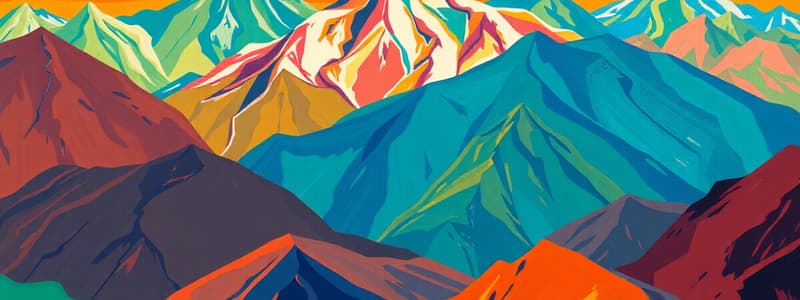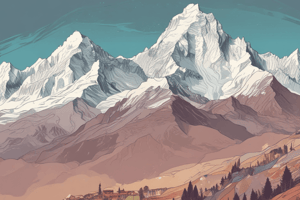Podcast
Questions and Answers
What percentage of the Earth's land does Asia cover?
What percentage of the Earth's land does Asia cover?
- 15%
- 50%
- 20%
- 30% (correct)
Which of the following is considered the highest point in Asia?
Which of the following is considered the highest point in Asia?
- Mt. Everest (correct)
- K2
- Lhotse
- Kangchenjunga
What is the estimated population percentage that Asia is home to?
What is the estimated population percentage that Asia is home to?
- 50%
- 40%
- 60% (correct)
- 70%
Which of the following regions is NOT one of the six main regions of Asia?
Which of the following regions is NOT one of the six main regions of Asia?
Which city is noted for having one of the largest populations in Asia?
Which city is noted for having one of the largest populations in Asia?
Which of the following languages is NOT one of the major languages spoken in Asia?
Which of the following languages is NOT one of the major languages spoken in Asia?
What is the lowest point in Asia?
What is the lowest point in Asia?
Which of the following descriptions best represents Asia?
Which of the following descriptions best represents Asia?
What is the highest mountain range in the world?
What is the highest mountain range in the world?
Which mountain range is part of the larger Himalayan system?
Which mountain range is part of the larger Himalayan system?
What role have the Hindu Kush mountains played in their region?
What role have the Hindu Kush mountains played in their region?
What is the length of the Ural Mountains?
What is the length of the Ural Mountains?
Which of the following statements about the Himalayas is true?
Which of the following statements about the Himalayas is true?
Which feature distinguishes the Ural Mountains?
Which feature distinguishes the Ural Mountains?
What defines a plateau?
What defines a plateau?
Which mountain range is known for significant mineral deposits?
Which mountain range is known for significant mineral deposits?
What is one way in which plateaus can be formed?
What is one way in which plateaus can be formed?
Which plateau is known as the 'Roof of the World'?
Which plateau is known as the 'Roof of the World'?
Which plateau is primarily located in southwestern Asia?
Which plateau is primarily located in southwestern Asia?
What major natural resource is abundant in the Iranian Plateau?
What major natural resource is abundant in the Iranian Plateau?
What geographical process can create plateaus through the movement of glaciers?
What geographical process can create plateaus through the movement of glaciers?
Which of the following rivers does NOT originate from the Tibetan Plateau?
Which of the following rivers does NOT originate from the Tibetan Plateau?
Which of the following describes the Deccan Plateau?
Which of the following describes the Deccan Plateau?
Which term refers to materials that settle at the bottom of a river or lake?
Which term refers to materials that settle at the bottom of a river or lake?
Flashcards
What is Asia's size and population?
What is Asia's size and population?
Asia is the largest and most populous continent, covering approximately 30% of Earth's land and home to about 60% of the global population.
Where is Asia located on the world map?
Where is Asia located on the world map?
Asia's geographic position connects various parts of the world, extending from the Arctic Ocean in the north to Europe in the west, the Pacific Ocean in the east, and the Indian Ocean in the south.
How is Asia divided?
How is Asia divided?
Asia comprises six main regions: Western, Central, Southern, Eastern, Southeastern, and Northern Asia. Each region exhibits its own unique cultural, historical, and geographical features.
What kind of landscapes does Asia have?
What kind of landscapes does Asia have?
Signup and view all the flashcards
How many countries are in Asia?
How many countries are in Asia?
Signup and view all the flashcards
What is a unique characteristic of Asian languages?
What is a unique characteristic of Asian languages?
Signup and view all the flashcards
What are some of the geographical extremes found in Asia?
What are some of the geographical extremes found in Asia?
Signup and view all the flashcards
What is Asia's population density?
What is Asia's population density?
Signup and view all the flashcards
What are the Himalayas?
What are the Himalayas?
Signup and view all the flashcards
What is the Hindu Kush?
What is the Hindu Kush?
Signup and view all the flashcards
What are the Ural Mountains?
What are the Ural Mountains?
Signup and view all the flashcards
What is a Plateau?
What is a Plateau?
Signup and view all the flashcards
What is the defining characteristic of a Plateau?
What is the defining characteristic of a Plateau?
Signup and view all the flashcards
How are Plateaus formed?
How are Plateaus formed?
Signup and view all the flashcards
What can be unique about Plateaus?
What can be unique about Plateaus?
Signup and view all the flashcards
What is the significance of Plateaus?
What is the significance of Plateaus?
Signup and view all the flashcards
What is erosion?
What is erosion?
Signup and view all the flashcards
What are sediments?
What are sediments?
Signup and view all the flashcards
What is tectonic uplift?
What is tectonic uplift?
Signup and view all the flashcards
What is a volcanic plateau?
What is a volcanic plateau?
Signup and view all the flashcards
What is a wind deposition plateau?
What is a wind deposition plateau?
Signup and view all the flashcards
What is a glacial erosion plateau?
What is a glacial erosion plateau?
Signup and view all the flashcards
Study Notes
Introduction to Asia
- Asia is the largest continent on Earth, encompassing roughly 30% of the Earth's landmass and home to about 60% of the global population.
- It stretches from the Arctic Ocean in the north to the Pacific Ocean in the east, the Indian Ocean in the south, and connects to Europe in the west.
- Asia is divided into six major regions: Western, Central, Southern, Eastern, Southeast, and Northern.
- Each region exhibits unique cultures, histories, and diverse landscapes, including deserts, mountains, and tropical forests.
- Asia's vast size and varied terrain shape its importance in connecting different parts of the world.
Mountain Ranges in Asia
-
Asia boasts some of the tallest and most beautiful mountains globally.
-
The Himalayas are the world's highest mountain range.
-
The Himalayas extend across several countries (e.g. India, Nepal, Bhutan) spanning approximately 2,400 kilometers (1,500 miles), with numerous peaks exceeding 8,000 meters (26,000 feet), including Mount Everest.
-
This range is significant for its natural beauty, challenging climbing routes, and rich biological diversity.
-
The Hindu Kush range stretches across Afghanistan, Pakistan, and Tajikistan.
-
It also plays a significant historic and cultural role in the region.
-
Significant portions of the Hindu Kush also have very high peaks, exceeding 7,000 meters (23,000 ft).
-
The Ural Mountains serve as a natural boundary between Europe and Asia.
-
While not as tall as other mountain ranges, they are a prominent geological feature important for mineral deposits.
-
The Ural Mountains provide habitats for various plant and animal species.
Asia Plateaus
- A plateau is characterized as a flat or gently sloping landform that's elevated in comparison to the surrounding region.
- Plateaus can be formed from geological processes like uplift, volcanic activity, or erosion.
- Asia's significant plateaus consist of the Deccan Plateau in South Central India, the Iranian Plateau in Southwestern Asia, and the Tibetan Plateau in East Asia.
- The Deccan Plateau is triangular-shaped and rich in fertile black soil, supporting agriculture.
- The Iranian Plateau is vast (approx. 3 million sq km), and home to significant deposits of natural gas and oil.
- The Tibetan Plateau, also known as the "roof of the world," is the highest and largest plateau.
- The Tibetan Plateau is a source for major rivers including the Indus, Ganges, Brahmaputra, Yangtze, and Yellow.
Studying That Suits You
Use AI to generate personalized quizzes and flashcards to suit your learning preferences.




